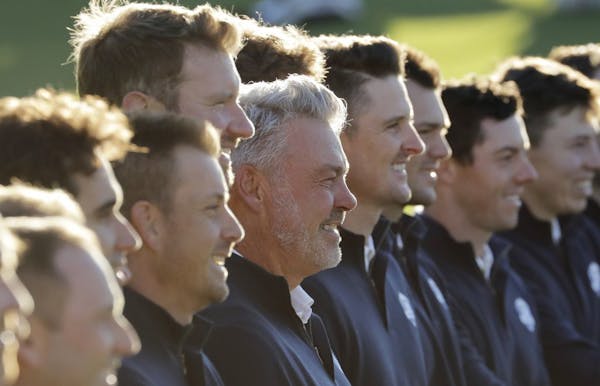How the scoring works
As confusing as the Ryder Cup might be at times, it still comes down to carding low scores. And those scorecards for Friday and Saturday, the days of two-man teams ahead of Sunday's singles action, are worth explaining.
Friday and Saturday begin with "foursomes" in the morning, and end with "four-ball" in the afternoon. Both sessions are two-man teams, U.S. vs. Europe. In foursomes, each pair uses one ball, with teammates alternating shots. In the afternoon four-ball, four balls are in play on each hole, with each golfer carding his own score. Here are imaginary scorecards on Hazeltine's first four holes to help show how this works: the team of Sid Hartman and Bud Grant vs. the team of Jack Nicklaus and the late-great Arnold Palmer.
Foursomes
Par4453
Hartman & Grant4364
Nicklaus & Palmer3453
How to read what happened: Alternating shots, remember, so only one score for each pair. The Nicklaus-Palmer team birdied No. 1 to go "1 up." Hartman and Grant birdied No. 2 to go "all-square." And Nicklaus and Palmer went par-par while Hartman and Grant bogeyed 3 and 4. So Nicklaus and Palmer are "2 up" with 14 holes to go.
Four-ball
Par4453
Hartman4754
Grant4352
Nicklaus4553
Palmer4342
How to read what happened: The difference in the afternoon is that each player cards his own score, and the lowest counts for the team. The Nicklaus-Palmer team here is "1 up" with 14 to go. The first hole was "halved," meaning no match points were awarded. Palmer birded the next three, and Grant matched two of those birdies. That means the Nicklaus-Palmer team has a one-hole advantage: "1 up." Because you take the lowest score of the pair for each hole, the pars and bogeys from Hartman and Nicklaus were rendered meaningless. (Jack and Arnie go on to win, of course.)
NFL draft attendees down for 3rd straight year. J.J. McCarthy among those who didn't go to Detroit
USA Track & Field expands its maternity policy to give athletes more time to work their way back

